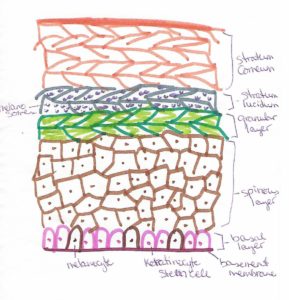Skin Cancer ABCDE [Show Notes]

Review
Epidermis = top layer of skin. Living cells divide and then add in proteins that causes cells to harden as they die and become and protective layer to keep out water and dirt and critters. Some of those proteins give your skin its color (melanin) and they help block and reflect UV light from the sun to keep the living cells from being damaged.
Mutations = if UV light damages the cells’ DNA, then when the cells divide and replicate, they copy the “error” and reproduce an abnormal cell. If certain mutations cause the cells to die, others cause the cells to be weak, but others cause the cells to become cancer.
3 types of skin cancer
- Basal cell carcinoma – most common of these 3, more common in people with fair skin. Skin growth is flesh colored, can look like skin tags. Caused when a basal cell gets mutated and starts to grow.
Squamous cell carcinoma – more common in people with fair skin. Scaly patches or sores that open, start to heal but reopen and never heal. Caused when a keratinocyte (living, dividing skin cell) gets mutated in the middle of replicating.
Melanoma – Moles are just a place where a lot of melanocytes gather in one place, but sudden moles or dark spots can be the tip of a bad iceberg. This is the deadliest type of skin cancer. Caused by mutations in the melanocytes.
Some benign (harmless) skin characteristics can resemble skin cancer, thus it’s easy to overlook them in the early stages.
A tool for early detection of melanoma
A – Asymmetry – you can’t fold it in half and all the edges match
B – Boarder – jaggedy, sharp boarders
C – Color – uneven color
D – Diameter – > 6mm (bigger than the eraser of a #2 pencil)
E – Evolving – changes shape, size, or color in a short amount of time (< 1 month)
This is why the National Skin Cancer Foundation recommends you do a monthly skin scan to check skin characteristics for changes or new ones.
Early detection is the number one step to improve survival of all cancers.
Precancer = Actinic Keratosis – dry and flakey places in the skin, can be the precursor of Squamous Cell Carcinoma. Usually shows up after 40 years old.
Cancer is not just a disease that happens to the aged, but as you age, the probability of you being exposed to something that could mutate your cells goes up.
Connect with me
Support us on Patreon
*NEW* Join the Pharmacist Answers Podcast Community on Facebook
Subscribe: iTunes, Stitcher, GooglePlay, TuneIn Radio
Music Credits: “Radio Martini” Kevin MacLeod (incompetech.com) Licensed under Creative Commons: By Attribution 3.0 http://creativecommons.org/licenses/by/3.0/

